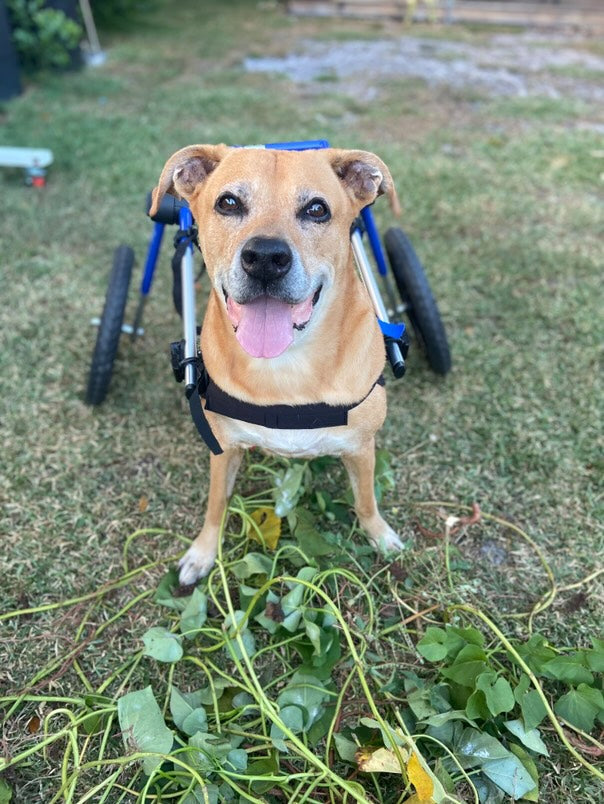Beagle Lifespan: How Long Do Beagles Live? (Life Expectancy)

How Do I Know If My Dog Has Degenerative Myelopathy?
Degenerative Myelopathy affects every aspect of that dog’s life. DM changes how a dog walks, moves, and stands. A diagnosis of degenerative myelopathy means significant changes in both your and your pet’s life. By educating yourself on the mobility condition, you can better prepare yourself for the future and the realities of caring for a dog with DM.
Understanding Degenerative Myelopathy and How DM Impacts a Dog's Mobility
Degenerative Myelopathy (often referred to as DM) is a degenerative mobility condition that affects a dog’s spinal cord. As a progressive mobility condition, dogs with degenerative myelopathy will experience significant changes in their ability to walk as the condition worsens and spreads.
As the spinal cord deteriorates, the rear limbs show signs of weakness which will lead to paralysis of the back legs. Similar to ALS or Lou Gehrig’s disease in humans, DM progresses down the spinal cord to eventually impact a dog’s front leg mobility and even the dog’s cognitive abilities.
Early Signs of Degenerative Myelopathy in Dogs
As DM progresses, the signs and symptoms are impossible to miss. The real challenge is noticing the signs of DM in the disease’s earliest stages. At the very beginning, degenerative myelopathy symptoms may only occur occasionally or be such a subtle change. This means that they are easy for unsuspecting pet parents to overlook.
Swaying While Standing
Most often, dogs in the early stages of mobility loss will start to lose strength in their hind legs first. This does not mean the dog is falling over or unable to stand. That will come later on as the dog's DM worsens. What you will see is a subtle swaying in a dog’s back end as they stand. This small shift indicates that your dog is losing strength and possibly muscle in their hind end. At this point in the dog’s mobility loss, if you give them a gentle nudge on their side, the dog is likely to lose their balance and fall over. They may not be ready for a dog wheelchair yet, but the rear support of a dog lifting harness may be necessary for trips outside or for stability on the stairs.
Knuckling and Dragging Paws
Dogs with nerve damage from degenerative myelopathy will struggle with their paw placement. Because they struggle with feeling their feet, dogs in the early stages of DM will unintentionally drag their paws when they walk or knuckle over. In more advanced cases, a dog that is knuckling may flip its paw upside down and walk on the top of its foot. At first, you may hear the sound of dragging toenails occasionally while walking your dog. If you think your dog is knuckling, check their toenails for signs of uneven wear. It’s quite common for a dog with degenerative myelopathy to drag its feet on one side of its paw more than the other side. Although DM nerve damage is permanent and will worsen, an anti-knuckling training tool can be used to help DM dogs with paw placement, even though it will not permanently correct the issue.
Difficulty Standing Up
One of the most common signs of mobility loss in a dog is struggling to stand up or push themselves up off the ground. Dogs with degenerative myelopathy will struggle to get their back legs underneath them when they attempt to stand, which may make them slow to rise or unable to stand up without assistance. Because the inability to stand can easily be attributed to a sign of old age, this is often missed. Any changes in your dog's life, whether it's behavioral or physical, need to be shared with your vet. Make note of any changes, as your observations can be key to diagnosing your dog as early as possible.
Additional Signs of DM in Dogs Include:
- Loss of coordination in the back legs
- Struggling on stairs or jumping
- Possible urinary incontinence
- Crossing back legs while standing or walking
- Noticeable muscle loss in the back legs
- Inability to go for long walks without tiring or legs giving out
What to Expect in Advanced Stages of Degenerative Myelopathy

Since the degenerative myelopathy symptoms will worsen over time, the changes in your dog’s mobility will be significant. In the later and more advanced stages of DM, weakness in the legs will progress to complete hind leg paralysis. The mobility loss will get to a point where the support and use of a dog wheelchair will be needed to keep your dog mobile. When choosing a mobility cart for degenerative myelopathy support, an adjustable wheelchair that features an optional front wheel attachment is ideal. As DM symptoms progress, mobility loss will spread to the dog’s front legs.
In the late stages of degenerative myelopathy, expect the disease to progress faster with significant changes in mobility. The progression of degenerative myelopathy will vary in every dog. However, DM typically takes anywhere from 6 months to 3 years. The more advanced stages of mobility loss usually occur after the first year of diagnosis. In its final stages, degenerative myelopathy can spread to the brain stem. This impacts cognitive function as well as the ability to breathe and swallow normally. At the same time, other vital organs will be impacted as well, including the lungs, kidneys, and heart. There is no cure for degenerative myelopathy, but there are ways you can help your dog. Through rehabilitation therapies for dogs with DM and mobility assistance, you can give your dog an excellent quality of life. Continued mobility and rehab exercises can help to slow the progression of DM.
Related Articles:












